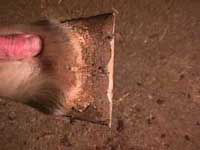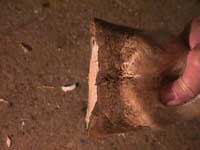To evaluate the hoof, watch the horse move, and look for limb interference and faulty movement. Observe the position of the hooves when the horse is standing squarely on the ground. The hooves should be uniform and balanced. There should not be any flaring in the quarters or curling of the toe.
Determine hoof balance by looking across the hoof from heel to toe. Both sides of the hoof wall should be equal in length. Horses that toe out and wing in wear down the inside of the hoof wall. Conversely, horses that toe in and paddle out wear down the outside of the hoof wall. If these conformational deviations are not corrected when the hoof is trimmed, the uneven wear will exacerbate the fault in conformation.
Steps for Trimming a Hoof
- 1. After evaluating the balance of the hoof and movement, the dead sole is trimmed from the sole area with a hoof knife. Enough sole has been removed when the sole flexes with thumb pressure.
- 2. The bars should be trimmed out level with the sole to prevent them from being broken or torn.
- 3. The ragged and loose edges of the frog should be trimmed so that the frog almost touches the ground when the hoof bears weight.
- 4. Remove the hoof wall with a pair of nippers. Begin nipping at the toe, and move around to the heels, making sure to keep the nippers perpendicular to the hoof wall to ensure a straight cut. After the nipper cut, sight down the hoof and check for balance. Both sides should be of equal length.
- 5. The hoof should be rasped level and not around the hoof wall.
- 6. Once the bottom of the hoof is level, the shaped hoof should be examined. Any lipping or flaring of the quarters or toe should be rasped until the hoof has the correct shape. The rasped area must be blended into the slope of the undistorted upper part of the wall.
The front hoof angle is usually 50 to 55 degrees. It should be the same length and angle as the shoulder. The angle of the hind hoof is usually 2 to 3 degrees greater than that of the front hoof.
Evaluating a Trim Job
When evaluating a trim job on a hoof, first evaluate the hoof on the ground for the correct shape and then from the bottom for levelness. Make sure the hoof is uniform, with no distortions. Then, pick up the hoof and sight down to make sure the hoof wall is level from side to side. Next, check the sole to make sure it is flexible to thumb pressure. It should not be so thin that walking on hard ground will make the horse sore. Check to make sure the frog has been trimmed properly, the front feet are the same angle and length, and the hind hooves are the same angle and length. Finally, watch the horse move. Make sure it is sound, not lame, following trimming.
Now that you understand ho to evaluate a trim job you’re ready to learn about a properly shod hoof.
Craig Wood, University of Kentucky





